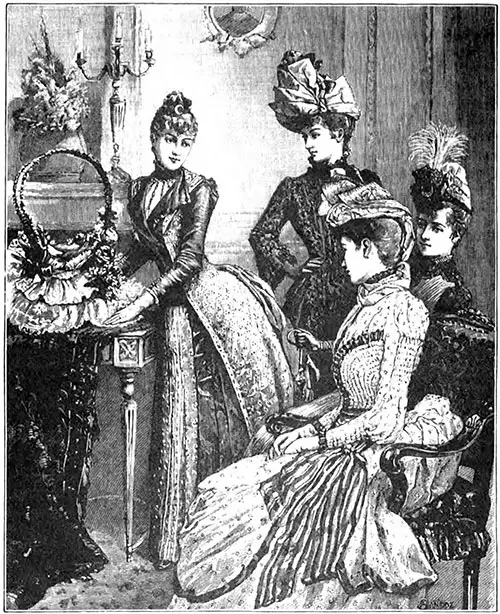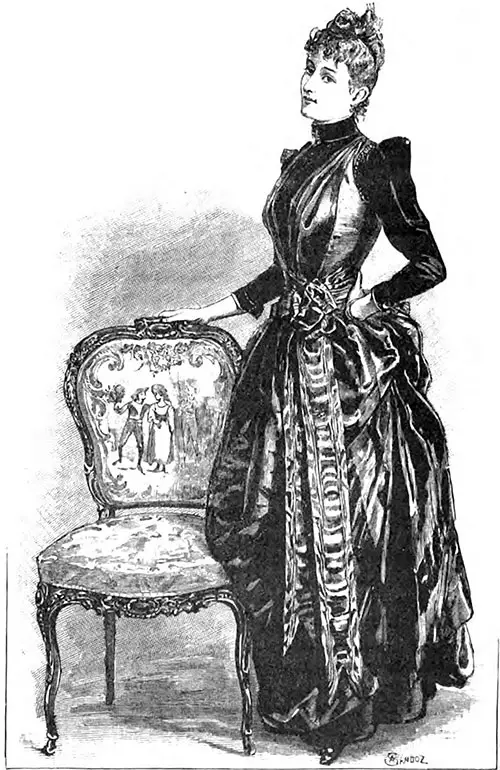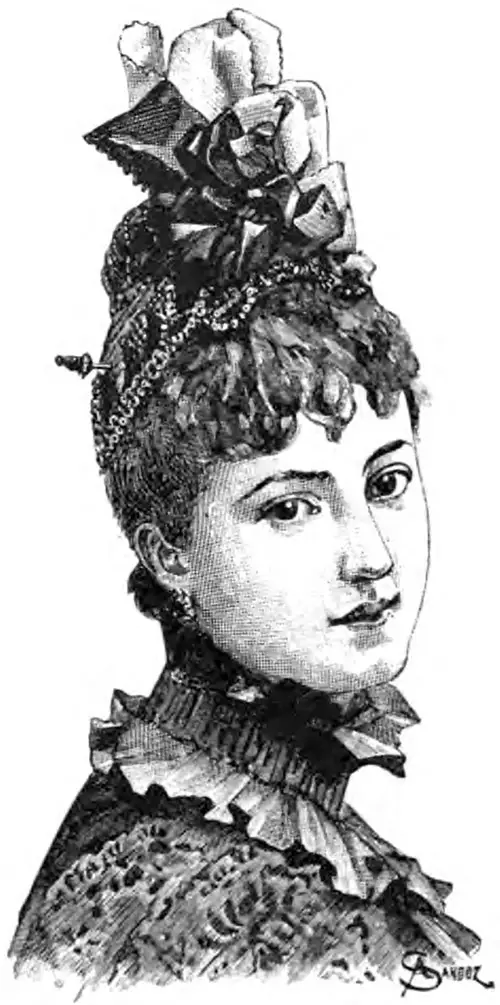Paris Fashions May 1888
A furor has seized the fashionable world for private theatricals. At Mme. Adam's, at the Marquise de Lillers', at the Baroness Marie de Lille's, at the Baroness Neily d'Orisel's, at Mme. Lippinau's (eldest daughter of Alexandre Dumas), the chief attraction of evening gatherings has been the acting of a Comedie de Salon.
Mme. Lippinau, by right of being her father's daughter and his pupil, has proved herself worthy to be his interpreter. There was a certain audacity in an amateur undertaking to play the part of the heroine in the Visile de Noces, immortalized by Descle'e, but Mme. Lippinau showed herself on this occasion an artist of no common order.
The setting in which the piece was given was perfect. At one end of the great hall a dainty theatre, erected by Bellois, nestled under crimson hangings. A gallery, supported by slender pillars of sculptured wood, ran around the hall; beyond gleamed the "Salle des Armes." The crowd of masculine guests who assembled there seemed composed of the most illustrious men of the day.
The ladies sat below in the hall, and, while waiting for the signal to be given that would cause the stage to vanish and the cotillon to begin, they applauded the Visite de Noces, and the farce which succeeded, Un Mariage dans un Chapeau, written in one evening of exuberant spirits by Alexandre Dumas, assisted by the incomparable Vivier.
But dress is our theme; let us therefore hasten to come to it. Mme. Lippinau, in La Visite de Noces, appeared in a Directoire déshabillé designed by Morin Blossier. It was composed of an under-gown of pink watered silk, and redingote of pearl-grey faille; the front, draped with creamy lace, fastened here and there with knots of pink ribbon. The Directoire scarf was pink.
For the ball, the charming hostess wore a pale, bright costume, also designed by Morin Blossier: a low-necked redingote gown of cream faille, the front covered with soft billows of Indian gauze; the bows of ribbon, and wide sash, knotted behind, were of maize watered silk.
The skirt was short, of course, clearing the ground all round; for Fashion has decreed that dowagers alone should this spring wear dresses with trains.
Mme. Armand, this lady's sister-in-law, wore a dress that led the mind back to France and the Court of Louis XV. The redingote over-dress was of Pompadour silk, the cream ground strewn over with flowers of natural hue.
The gown looped up with bows of moss-green velvet and opened in front, displayed a petticoat of rosewood-colored satin, edged with a thick pinked-out ruché. A cascade of bows of moss green velvet and rosewood satin descended down the front of the bodice.
The Maison Morin Blossier has excelled itself lately in turning out delicate creations. One dress for the beautiful Countess de Villeneuve - Albuquerque, in its shimmering of lilac satin and shot taffetas, gleaming with every shade of grey running into purple found on the wood-pigeon's breast, was one of its happiest designs.
The skirt (straight, as all skirts are now made in front and at the sides) was edged with a thick ruché of the shot taffetas; bows of lilac satin ribbon fastened the front of the bodice.
Another gown for the same lady was of slate-grey watered silk, striped with satin; the front of the skirt was draped; the redingote à la Barras was ornamented with collar and cuffs of gold embroidery. A guimpe and over-sleeves of gold tulle were to be worn with this dress.

Visiting Costumes from the Maison Laferrière. Bonnet, and Basket for Bon-eons, from the Maison Virot.
A visiting-dress was composed of moss-green faille. The straight skirt, fringed with jet, opened on one side, displaying a petticoat of black brocade, flowered over with white lilac and dim gold foliage.
The brocade was repeated on the waistcoat, the narrow revere of which and the cutis were of moss-green velvet. A thick jabot of white crape gave a bright finishing touch to the costume.
Another dress of tender vernal harmonies—for green in all its varied shades, from deep emerald to the freshest tones of opening leaves, is a favorite color—was of young-moss-green faille, brocaded with the golden-green of newly unfolded euonymus; the front of the skirt was draped.
The back of the bodice and a narrow-gathered train were of pale moss-green satin lined with golden green; the scarf was of the latter tone.

Costume from the Maison Doucet
Our illustration of a costume from the Maison Doucet may be studied with benefit by those who would fain understand the secret of that elegant simplicity in which the Parisian artist in chiffons excels.
Those deft French fingers possess the art of draping as no other fingers do. By catching up a fold here and there they bring about results of line which are the despair of dressmakers of other nations to imitate.
No ingenuity in trimming or splendor of texture used can replace the effect to be attained by the artistic manipulation of folds in drapery.
This "robe Doucet" is composed of an under-dress of black plush, and sleeveless polonaise of black pekin, widely striped black satin, and sicilieune.
The polonaise is slightly draped; the folds fall as if the drapery had been thrown carelessly over the wearer's head and allowed to fall in its own way, being kept in its place by a stitch here and there.
The black plush is repeated in the plastron of the bodice, and in the sleeves, which, placed high over the shoulders, have a suggestion of mediaeval picturesqueness; a gleam of jet trimming introduced here gives a touch of brightness to this perfectly simple costume. The sash, with floating ends tied at the side, is of black watered ribbon.
The last decree of Fashion is to be sought for in the dainty, fresh spring costumes that with May will come into favor. The windows of the old-established Maison La Ferriere, Rue Taitbout, are beginning to blossom like a parterre of flowers.
For twenty years this house has sustained a reputation for elegance that made it Worth's rival under the Empire, and now that of the Maison Morin Blossier.
Our illustrations will give an idea of some of the pretty costumes made in the modified Empire style now so much in vogue.
A Duchesse de Berri gown of foulard, the ecru ground strewn with pink flowers of tender old-rose tone; the straight skirt bordered at the hem with a band of old rose-colored ribbon; the simply draped tunic lifted over the hips.
The bodice, gathered and pleated into a corselet of old-rose silk, is bound round the waist with a wide sash of the same rose silk, hemmed at the ends and fastened in a large knot at the side.
With this dress is to be worn a bonnet of coarse, unbleached straw, the front resting on a turban of old-rose crape, the outside trimmed with bows of straw and deep crimson velvet.
More graceful still, if somewhat audaciously quaint in color, is a Directoire costume of shot green and red taffetas; the skirt falls in flat folds and is adorned in front with four high quilting covered with embroidery wrought in unbleached silk.
The redingote a Incroyable, with large revere half hidden by those of the waistcoat, is likewise embroidered; the waistcoat and sleeves are of simple taffetas; the waistcoat opens over a shirt of thick white crepe, embroidered in green and red.
Another novelty comes in the form of the large "casaque Dubarry," composed of Spanish blonde, laid in flat folds over silk. In our illustration the silk and lace are black, adorned with a collar, a jabot, and waistbands of quilted ribbon, shot like a wood-pigeon's breast.
The sash, a simple band of the same ribbon, is tied behind or at the side. The round hat is of black straw, lifted on one side with loops of shot ribbon, from which rises an aigrette of red roses and green leaves.
Contrasting in its joyous brightness of tints with the somewhat sober richness of this last costume is an Empire dress, flat in its outline of gathered folds. It is of taffetas of the delicate shot blue known as Eau de Nil, covered with minute stripes of "lotus-leaf" green.
The collar, the flat sleeves, and the sash are of pale blue brocaded silk. Plaques of assorted passementerie are introduced as trimming. With this dress is worn a Josephine capote of blue crape, trimmed in front with shell-like loops of lace of the new "putty" tint held by a crescent of gold.
The aigrette is blue mingled with gold. This "putty" tint is pretty, notwithstanding its ugly name; it is a sweet, warm tone of grey with a touch of fawn, and is known as "bise" in French.
Shot taffetas is the favorite fabric for spring dresses; its shifting hues seem in harmony with the transition period of the year, and it holds its place between the richer faille and the thinner foulard.
A dress turned out by the Maison Lafeiriere of "abricot" taffetas shot with ivory-white, the skirt draped and hemmed with "bise" guipure, was a very graceful example of a warm light harmony wrought in color and stuffs.
The polonaise worn with this dress was cut coat fashion behind in long narrow flaps; the front displayed a gathered plastron, striped with bands of guipure.
The straight high collar and the cuffs were trimmed with guipure. A sash of black watered silk ribbon tied at the side gave an effective finish to the dress.
Another costume was of shot silk that ran through every tone of rose from that of the dying rose to flame, mingled with miniature stripes of ivory-white. The "casaque Princesse" opened at the side and displayed a petticoat veiled and draped with black lace.
The collar, the cuffs, and the great jabot that was gathered in at the waist by the sash of black watered ribbon, were of black lace. Wide floating half-sleeves of black lace fell at the shoulders, like epaulettes.
A new and somewhat startling combination of color is of dried plum or currant-colored silk, shot with cherry. Such a dress made with a polonaise cut open revealed a bodice of crimson faille embroidered with Pompadour flowers.
The high straight collar and cuffs were of a shaded brilliant red ribbon laid on flat. The sash, very wide and tied in loops, was half of Pompadour taffetas, half of the brilliant shaded red ribbon. One of the new colors is "ventre de biche," a warm delicate fawn.
A costume of this color, in the old-fashioned fabric mousseline de laine, was made with a skirt falling in straight wide folds to the ankles; on each fold was laid a black silk watered ribbon, striping the skirt from waist to hem.
The gathered bodice was trimmed with a plastron of black watered silk; across it, from the right shoulder was brought round a sautoir of the same ribbon. The straight high collar, the cuffs, and the sash were of black watered silk.
From dresses let us pass to bonnets. The great Parisian milliners are now only disclosing the result of their secret conclave's decision regarding the summer fashions. The edict has gone forth that the pretty feathered denizens of the woods are no longer to be immolated for the adornment of woman.
Feathers are proscribed. Flowers; bows of ribbon, of crape or gauze; scintillations of gold and silver are to replace plumes.
All the artificial flower makers are at work in Paris and in the Southern departments, imitating blossoms with a delicacy and faithfulness of representation as if they were disciples of Mother Nature herself.
Balzac in his marvelous story, "Honorine," has described a woman earning her bread by making artificial flowers. He shows her living surrounded by plants, sharing their life as an artist shares that of the nature he paints.
The supreme novelist has not exaggerated the toil some artificial flower makers expend upon their creations. Not a few copyists of flowers in France literally live among growing plants, studying every delicate shoot, finding no detail too trivial to copy, no toil too arduous to expend upon imitation of the living model.
Flower-making, there, is an art pursued in an artistic spirit. The secret of the exquisite grace, the perfect droop, and the realistic tenderness of hue in French artificial flowers, lies in this arduous and loving imitation of nature.
To return to our theme: bonnets, except those influenced by the Directoire style of head-gear, are to be small capotes. These capotes are to be adorned with an aigrette of flowers rising above the brow from loops of ribbon or gossamer material.
Rose-tipped daisies, cows lips, forget-me-nots, lilacs, violets, all the pageantry of sweet spring blossoms form the present favorite floral livery.
Sometimes the crown of the bonnet is literally covered with blossoms; sometimes they garland it round, rising above the forehead in a diadem; oftener they nestle among the loops of ribbon, or lie in sprays, looping up the uplifted side of the round hats that are now in vogue in Paris.
Green is a favorite color, but amongst the new colors that vie with it, in our Parisienne's estimation, is the "gant de Suede" brown, a delicate tan which mingles admirably with gold.
A capote of this color in crepe de Chine with an aigrette of tulle of the same soft tint, on which rested a cluster of roses and buds of gold mingling with green leaves, the gathered folds of the capote caught by a ribbon of gold and brown passementerie, was shown at the Maison Pariset.
In Virot's show-rooms we are surrounded by pretty capotes of crape and embroidered stuffs, mingling with large round straw hats lifted on one side with great sprays of flowers and bows of ribbon; and with toques, coquettishly touched with gold gleaming under clusters of feathers and aigrettes of ribbon.
Here are some of the models on view. An Empire bonnet, with soft crown of crape or embroidered gauze, and border of cut straw. A band and loops of velvet embroidered with ears of corn, harmonizing with the straw, surround the crown, under a tuft of feathers.

Russian Bonnet from the Maison Virot
The Russian toque comes next in favor. Last winter this coquettish head-gear was made of phosphor scent velvet, the crown gathered and trimmed with sable.
The crown is now composed of Oriental embroideries; the lifted border festooned with gold and outlined with pearls. An aigrette of bows of pistache-green satin and pale pink is placed in front.
The charming Countess Runsky Kartskoff first wore this daintily gorgeous headgear, and it has since become fashionable.
As the bonnet may be considered the crown of a woman's out-door costume, so the cap appears as the finishing touch of her indoor déshabillé.
At Virot's I saw a collection of those pretty head dresses, all fantastic and picturesque.
A "Cleopatra" cap, in satin of the new copper color—a brilliant yet tender shade of orange—damasked with gold and trimmed with a circlet composed of a double row of gold sequins; the crown gathered and quilted in the form of uplifted cars on the sides.
A "Sultane" cap of sky-blue and silver damask, with sides of moss-green velvet, braided with gold, tied up at the top of the head with bows of pale blue ribbon.
A "Baby" coiffe in deep pansy velvet, with crown of lilac satin, veiled with steel embroidery, the border outlined with steel, and trimmed with clusters of lilac ribbon.
A velvet Medici toque of the shade of green known as " vert antique," covered with embroidery of the Renaissance pattern; bordered with pearls and trimmed with a panache of gold on one side.
The "Isabeau" cap, an austerely picturesque head-gear of thick white crape, crinkled and edged with a double row of festoons; a short veil fastened with black velvet bows falling behind.
The "Henri II" cap is of crimson velvet, embroidered in gold chenille. The velvet rising in a crest in front, is lined with pink satin, and fastened by knots of roses.
I forgot to mention that Lentherie, of the Rue St. Honore, was the designer of the pretty head-dress for a fancy ball, an illustration of which accompanied my last letter.
Johnstone, Violette, “May Fashions: Paris,” in The Woman’s World, Cassell & Company, Limited, London, Paris, New York & Melbourne, Volume I, No. 7, May 1888, p. 333-336.

